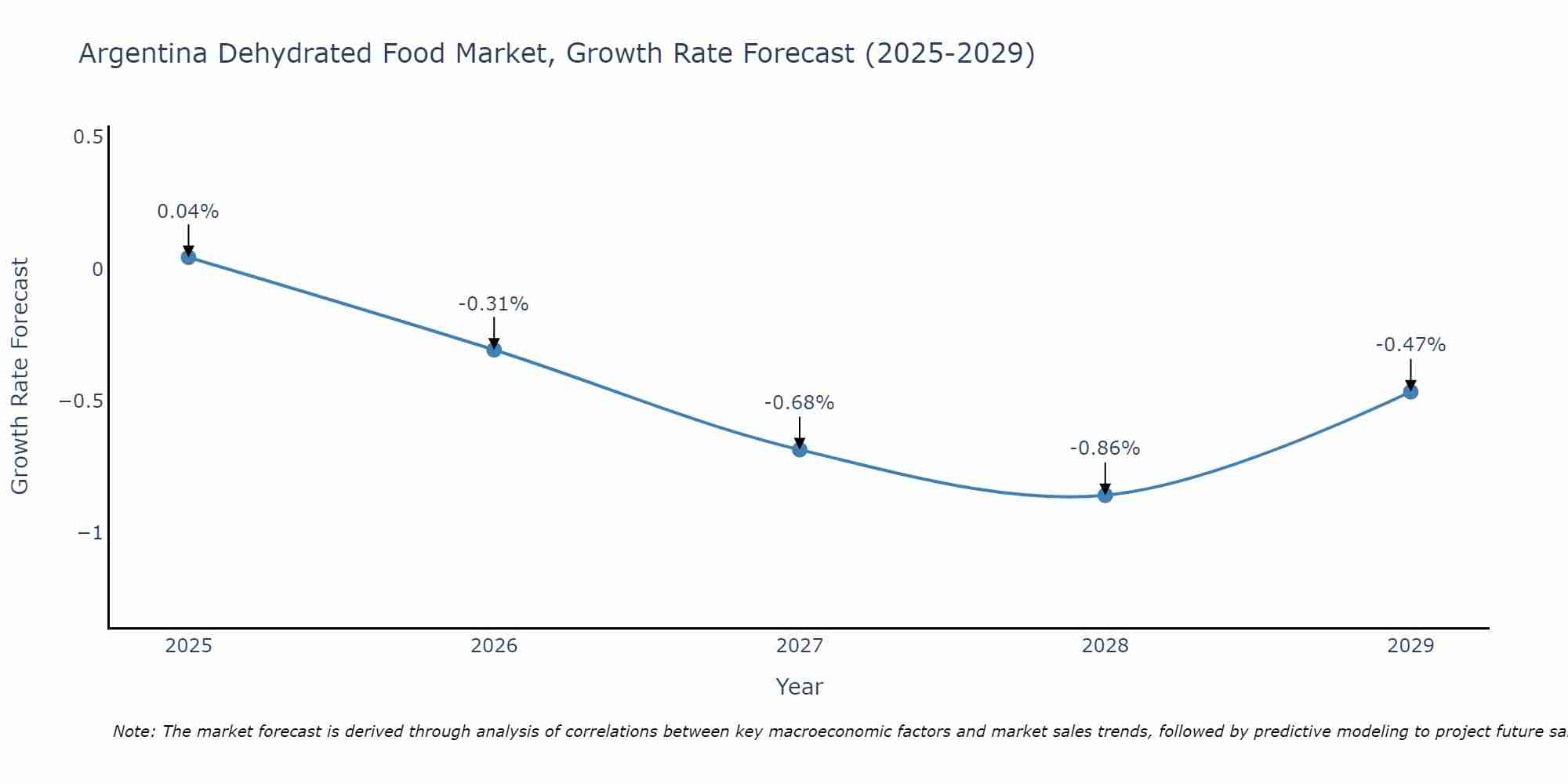Argentina Dehydrated Food Market (2025 - 2031) | COVID-19 IMPACT, Revenue, Value, Size, Trends, Industry, Analysis, Companies, Forecast, Share & Growth
| Product Code: ETC175764 | Publication Date: Jan 2022 | Updated Date: Apr 2025 | Product Type: Market Research Report | |
| Publisher: 6Wresearch | Author: Ravi Bhandari | No. of Pages: 70 | No. of Figures: 35 | No. of Tables: 5 |
Argentina Dehydrated Food Market Size Growth Rate
The Argentina Dehydrated Food Market is projected to witness mixed growth rate patterns during 2025 to 2029. Starting high at 0.04% in 2025, the market steadily declines to -0.47% by 2029.

Argentina Dehydrated Food Market Synopsis
The dehydrated food market in Argentina is experiencing steady growth owing to changing consumer preferences, convenience, and longer shelf life offered by dehydrated food products. Additionally, the agricultural abundance in Argentina provides ample opportunities for the production of dehydrated fruits, vegetables, and meat, further driving market growth.
Drivers of the market
Changing consumer lifestyles and a growing preference for convenience foods are driving the Argentina dehydrated food market. Dehydrated food products offer several advantages such as extended shelf life, reduced weight and volume, and retention of nutritional value, making them ideal for storage and consumption, especially in remote or disaster-prone areas. Additionally, technological advancements in dehydration techniques and packaging solutions are expanding the variety and appeal of dehydrated food products in Argentina.
Challenges of the market
The Argentina dehydrated food market faces several challenges amidst its growth prospects. One notable challenge is the perception of dehydrated food as inferior in terms of taste and nutritional value compared to fresh produce, which can deter consumer acceptance. Overcoming these misconceptions requires extensive marketing efforts and education about the benefits of dehydrated foods, such as longer shelf life and convenience. Moreover, fluctuations in raw material prices, especially for fruits and vegetables, pose challenges for manufacturers in terms of cost management and pricing strategies. Additionally, ensuring food safety and quality standards throughout the dehydration process is essential to maintain consumer trust and regulatory compliance.
Government Policy of the market
Government policies regarding food safety, agriculture, and trade influence the dehydrated food market in Argentina. Regulations govern the production, packaging, labeling, and distribution of dehydrated food products to ensure consumer health and safety. Additionally, agricultural policies, such as subsidies for crop production and export tariffs, impact the availability and cost of raw materials used in dehydrated food processing.
Key Highlights of the Report:
- Argentina Dehydrated Food Market Outlook
- Market Size of Argentina Dehydrated Food Market, 2024
- Forecast of Argentina Dehydrated Food Market, 2031
- Historical Data and Forecast of Argentina Dehydrated Food Revenues & Volume for the Period 2021-2031
- Argentina Dehydrated Food Market Trend Evolution
- Argentina Dehydrated Food Market Drivers and Challenges
- Argentina Dehydrated Food Price Trends
- Argentina Dehydrated Food Porter's Five Forces
- Argentina Dehydrated Food Industry Life Cycle
- Historical Data and Forecast of Argentina Dehydrated Food Market Revenues & Volume By Type for the Period 2021-2031
- Historical Data and Forecast of Argentina Dehydrated Food Market Revenues & Volume By Spray-dried for the Period 2021-2031
- Historical Data and Forecast of Argentina Dehydrated Food Market Revenues & Volume By Freeze-dried for the Period 2021-2031
- Historical Data and Forecast of Argentina Dehydrated Food Market Revenues & Volume By Vacuum-dried for the Period 2021-2031
- Historical Data and Forecast of Argentina Dehydrated Food Market Revenues & Volume By Drum-dried for the Period 2021-2031
- Historical Data and Forecast of Argentina Dehydrated Food Market Revenues & Volume By Others for the Period 2021-2031
- Historical Data and Forecast of Argentina Dehydrated Food Market Revenues & Volume By Product for the Period 2021-2031
- Historical Data and Forecast of Argentina Dehydrated Food Market Revenues & Volume By Dried Processed Food for the Period 2021-2031
- Historical Data and Forecast of Argentina Dehydrated Food Market Revenues & Volume By Dried Fruit & Vegetable for the Period 2021-2031
- Historical Data and Forecast of Argentina Dehydrated Food Market Revenues & Volume By Dried Dairy for the Period 2021-2031
- Historical Data and Forecast of Argentina Dehydrated Food Market Revenues & Volume By Dried Meat & Seafood for the Period 2021-2031
- Historical Data and Forecast of Argentina Dehydrated Food Market Revenues & Volume By Others for the Period 2021-2031
- Historical Data and Forecast of Argentina Dehydrated Food Market Revenues & Volume By Distribution Channel for the Period 2021-2031
- Historical Data and Forecast of Argentina Dehydrated Food Market Revenues & Volume By Hypermarket/Supermarket for the Period 2021-2031
- Historical Data and Forecast of Argentina Dehydrated Food Market Revenues & Volume By Convenience Stores for the Period 2021-2031
- Historical Data and Forecast of Argentina Dehydrated Food Market Revenues & Volume By Online Retailing for the Period 2021-2031
- Historical Data and Forecast of Argentina Dehydrated Food Market Revenues & Volume By Others for the Period 2021-2031
- Argentina Dehydrated Food Import Export Trade Statistics
- Market Opportunity Assessment By Type
- Market Opportunity Assessment By Product
- Market Opportunity Assessment By Distribution Channel
- Argentina Dehydrated Food Top Companies Market Share
- Argentina Dehydrated Food Competitive Benchmarking By Technical and Operational Parameters
- Argentina Dehydrated Food Company Profiles
- Argentina Dehydrated Food Key Strategic Recommendations
Frequently Asked Questions About the Market Study (FAQs):
1 Executive Summary |
2 Introduction |
2.1 Key Highlights of the Report |
2.2 Report Description |
2.3 Market Scope & Segmentation |
2.4 Research Methodology |
2.5 Assumptions |
3 Argentina Dehydrated Food Market Overview |
3.1 Argentina Country Macro Economic Indicators |
3.2 Argentina Dehydrated Food Market Revenues & Volume, 2021 & 2031F |
3.3 Argentina Dehydrated Food Market - Industry Life Cycle |
3.4 Argentina Dehydrated Food Market - Porter's Five Forces |
3.5 Argentina Dehydrated Food Market Revenues & Volume Share, By Type, 2021 & 2031F |
3.6 Argentina Dehydrated Food Market Revenues & Volume Share, By Product, 2021 & 2031F |
3.7 Argentina Dehydrated Food Market Revenues & Volume Share, By Distribution Channel, 2021 & 2031F |
4 Argentina Dehydrated Food Market Dynamics |
4.1 Impact Analysis |
4.2 Market Drivers |
4.3 Market Restraints |
5 Argentina Dehydrated Food Market Trends |
6 Argentina Dehydrated Food Market, By Types |
6.1 Argentina Dehydrated Food Market, By Type |
6.1.1 Overview and Analysis |
6.1.2 Argentina Dehydrated Food Market Revenues & Volume, By Type, 2021-2031F |
6.1.3 Argentina Dehydrated Food Market Revenues & Volume, By Spray-dried, 2021-2031F |
6.1.4 Argentina Dehydrated Food Market Revenues & Volume, By Freeze-dried, 2021-2031F |
6.1.5 Argentina Dehydrated Food Market Revenues & Volume, By Vacuum-dried, 2021-2031F |
6.1.6 Argentina Dehydrated Food Market Revenues & Volume, By Drum-dried, 2021-2031F |
6.1.7 Argentina Dehydrated Food Market Revenues & Volume, By Others, 2021-2031F |
6.2 Argentina Dehydrated Food Market, By Product |
6.2.1 Overview and Analysis |
6.2.2 Argentina Dehydrated Food Market Revenues & Volume, By Dried Processed Food, 2021-2031F |
6.2.3 Argentina Dehydrated Food Market Revenues & Volume, By Dried Fruit & Vegetable, 2021-2031F |
6.2.4 Argentina Dehydrated Food Market Revenues & Volume, By Dried Dairy, 2021-2031F |
6.2.5 Argentina Dehydrated Food Market Revenues & Volume, By Dried Meat & Seafood, 2021-2031F |
6.2.6 Argentina Dehydrated Food Market Revenues & Volume, By Others, 2021-2031F |
6.3 Argentina Dehydrated Food Market, By Distribution Channel |
6.3.1 Overview and Analysis |
6.3.2 Argentina Dehydrated Food Market Revenues & Volume, By Hypermarket/Supermarket, 2021-2031F |
6.3.3 Argentina Dehydrated Food Market Revenues & Volume, By Convenience Stores, 2021-2031F |
6.3.4 Argentina Dehydrated Food Market Revenues & Volume, By Online Retailing, 2021-2031F |
6.3.5 Argentina Dehydrated Food Market Revenues & Volume, By Others, 2021-2031F |
7 Argentina Dehydrated Food Market Import-Export Trade Statistics |
7.1 Argentina Dehydrated Food Market Export to Major Countries |
7.2 Argentina Dehydrated Food Market Imports from Major Countries |
8 Argentina Dehydrated Food Market Key Performance Indicators |
9 Argentina Dehydrated Food Market - Opportunity Assessment |
9.1 Argentina Dehydrated Food Market Opportunity Assessment, By Type, 2021 & 2031F |
9.2 Argentina Dehydrated Food Market Opportunity Assessment, By Product, 2021 & 2031F |
9.3 Argentina Dehydrated Food Market Opportunity Assessment, By Distribution Channel, 2021 & 2031F |
10 Argentina Dehydrated Food Market - Competitive Landscape |
10.1 Argentina Dehydrated Food Market Revenue Share, By Companies, 2024 |
10.2 Argentina Dehydrated Food Market Competitive Benchmarking, By Operating and Technical Parameters |
11 Company Profiles |
12 Recommendations |
13 Disclaimer |
- Single User License$ 1,995
- Department License$ 2,400
- Site License$ 3,120
- Global License$ 3,795
Search
Related Reports
- Portugal Electronic Document Management Market (2025-2031) | Strategy, Consumer Insights, Analysis, Investment Trends, Opportunities, Growth, Size, Share, Industry, Revenue, Segments, Value, Segmentation, Supply, Forecast, Restraints, Outlook, Competition, Drivers, Trends, Demand, Pricing Analysis, Competitive, Strategic Insights, Companies, Challenges
- France Electronic Document Management Market (2025-2031) | Strategy, Consumer Insights, Analysis, Investment Trends, Opportunities, Growth, Size, Share, Industry, Revenue, Segments, Value, Segmentation, Supply, Forecast, Restraints, Outlook, Competition, Drivers, Trends, Demand, Pricing Analysis, Competitive, Strategic Insights, Companies, Challenges
- Portugal Occupational Health & Safety Services Market (2025-2031) | Strategy, Consumer Insights, Analysis, Investment Trends, Opportunities, Growth, Size, Share, Industry, Revenue, Segments, Value, Segmentation, Supply, Forecast, Restraints, Outlook, Competition, Drivers, Trends, Demand, Pricing Analysis, Competitive, Strategic Insights, Companies, Challenges
- Netherlands Occupational Health and Safety Services Market (2025-2031) | Strategy, Consumer Insights, Analysis, Investment Trends, Opportunities, Growth, Size, Share, Industry, Revenue, Segments, Value, Segmentation, Supply, Forecast, Restraints, Outlook, Competition, Drivers, Trends, Demand, Pricing Analysis, Competitive, Strategic Insights, Companies, Challenges
- Belgium and Luxembourg Facility Management Market (2025-2031) | Strategy, Consumer Insights, Analysis, Investment Trends, Opportunities, Growth, Size, Share, Industry, Revenue, Segments, Value, Segmentation, Supply, Forecast, Restraints, Outlook, Competition, Drivers, Trends, Demand, Pricing Analysis, Competitive, Strategic Insights, Companies, Challenges
- Russia Women Intimate Apparel Market (2025-2031) | Strategy, Consumer Insights, Analysis, Investment Trends, Opportunities, Growth, Size, Share, Industry, Revenue, Segments, Value, Segmentation, Supply, Forecast, Restraints, Outlook, Competition, Drivers, Trends, Demand, Pricing Analysis, Competitive, Strategic Insights, Companies, Challenges
- Africa Chocolate Market (2025-2031) | Size, Share, Trends, Growth, Revenue, Analysis, Forecast, industry & Outlook
- Global Hydroxychloroquine And Chloroquine Market (2025-2031) | Industry, Trends, Size, Outlook, Growth, Value, Companies, Revenue, Analysis, Share, Forecast
- Saudi Arabia Plant Maintenance Market (2025-2031) | Industry, Size, Growth, Revenue, Value, Companies, Forecast, Analysis, Share & Trends
- Taiwan Electric Truck Market (2025-2031) | Outlook, Industry, Revenue, Size, Forecast, Growth, Analysis, Share, Companies, Value & Trends
Industry Events and Analyst Meet
Our Clients
Whitepaper
- Middle East & Africa Commercial Security Market Click here to view more.
- Middle East & Africa Fire Safety Systems & Equipment Market Click here to view more.
- GCC Drone Market Click here to view more.
- Middle East Lighting Fixture Market Click here to view more.
- GCC Physical & Perimeter Security Market Click here to view more.
6WResearch In News
- Doha a strategic location for EV manufacturing hub: IPA Qatar
- Demand for luxury TVs surging in the GCC, says Samsung
- Empowering Growth: The Thriving Journey of Bangladesh’s Cable Industry
- Demand for luxury TVs surging in the GCC, says Samsung
- Video call with a traditional healer? Once unthinkable, it’s now common in South Africa
- Intelligent Buildings To Smooth GCC’s Path To Net Zero













